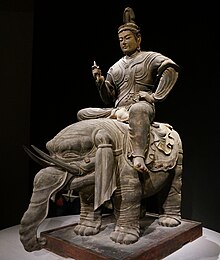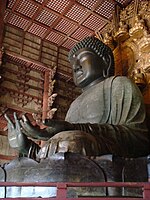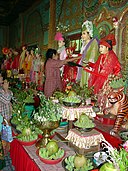|
Śakra (Buddhism)
Śakra (Sanskrit: शक्र Śakra; Pali: सक्क Sakka) is the ruler of the Trāyastriṃśa Heaven according to Buddhist cosmology. He is also referred to by the title "Śakra, Lord of the Devas" (Sanskrit: Śakra devānāṃ indraḥ; Pali: Sakka devānaṃ inda).[1] The name Śakra ("powerful") as an epithet of Indra is found in several verses of the Rigveda. In East Asian cultural traditions, Śakra is known as Dìshìtiān (帝釋天) or Shìtí Huányīn (釋提桓因) in Chinese, as Taishakuten (帝釈天) in Japanese, as Jeseokcheon (제석천) in Korean, and as Đế Thích Thiên (帝釋天) or Thích Đề Hoàn Nhân (釋提桓因) in Vietnamese. In Chinese Buddhism, Śakra is sometimes identified with the Taoist Jade Emperor (Yùhuáng Dàdì 玉皇大帝, often simplified to Yùhuáng 玉皇); both share a birthday on the ninth day of the first lunar month of the Chinese calendar (usually in February). The Trāyastriṃśa heaven in which Śakra rules is located on the top of Mount Meru, imagined to be the polar center of the physical world, around which the Sun and Moon revolve. Trāyastriṃśa is the highest of the heavens in direct contact with humankind. Like all deities, Śakra is long-lived but mortal. When one Śakra dies, his place is taken by another deity who becomes the new Śakra. Several stories about Śakra are found in the Jataka tales, as well as several suttas. Śakra is married to Sujā,[2] daughter of the chief of the asuras, Vemacitrin (Pāli Vepacitti). Despite this relationship, a state of war generally exists between the thirty-three gods and the asuras, which Śakra manages to resolve with minimal violence and no loss of life. Śakra is often depicted in literature as a being who consults the Buddha on matters of morality. Together with Brahmā, he is considered a dharmapala, a protector of Buddhism. Etymology"Śakra" is a Sanskrit word meaning ""mighty"" or "powerful," and is used as an epithet of Indra in hymn 5.34 of the Rigveda. The related Pāli lexeme "Sakka" seems to have been the standard name of the king of heaven in Buddhist tradition. NamesŚakra is known by several names in Buddhist texts. Some of these include:
TheravādaSakka's mythology and character is expounded upon in the Pali Canon, particularly in the Sakka Saṃyutta of the Saṃyutta Nikāya. Sakka plays a significant role in several of the Jātaka tales. The commentator Buddhaghoṣa has identified Sakka as being identical to Vajrapāṇi. In the Mahāparinibbāna Sutta (DN 16), Sakka speaks the following verse, which has become standard in Buddhist funeral rites:
MahāyānaIn the Book of Equanimity, Śakra plays a central role in the fourth koan. In the Mahāparinirvāṇa Sūtra, Śakra utters a stanza in response to the Buddha's death as a recognition of the Four Noble Truths. It is identical to the Pali formula found in the corresponding sutta.:[3]
He is also recognized as one of the Twenty-Four Guardian Devas in Chinese Buddhist tradition.[4] IconographyIn Southeast Asia's Theravada communities, Śakra is depicted with blue or black skin, alongside a mount, Airavata, a three-headed elephant.[5] Folk beliefŚakra is equated with Haneullim in Korean folk religion. According to the Memorabilia of the Three Kingdoms, it is believed that Śakra is Hwanung's father. In Chinese Buddhism, some equate him with the Jade Emperor. In Mongolian Buddhism, Qormusta Tengri is syncretized with Śakra, and is believed to be involved with the creation of fire.
The ceremonial name of Bangkok alludes to Śakra:[6]
This name is composed of both Pāli and Sanskrit, prefaced with the only one Thai word, Krung, which means 'capital'. It can thus be written as: "Krung-dēvamahānagara amararatanakosindra mahindrāyudhyā mahātilakabhava navaratanarājadhānī purīramya uttamarājanivēsana mahāsthāna amaravimāna avatārasthitya shakrasdattiya vishnukarmaprasiddhi."  Popular cultureŚakra makes several appearances in popular culture, including:
See alsoCounterparts of Śakra in other cultures
References
Bibliography
|
|||||||||||||||||||||||||||||||||||||||||||||||||||||||||





